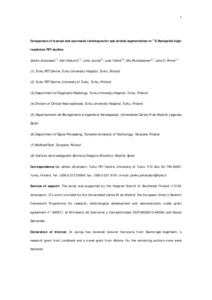Comparison of manual and automatic techniques for substriatal segmentation in C-11-raclopride high-resolution PET studies
Kati Alakurtti; Juho Joutsa; Jarkko Johansson; Ulla Ruotsalainen; Jussi Tohka; Juha O. Rinne
Comparison of manual and automatic techniques for substriatal segmentation in C-11-raclopride high-resolution PET studies
Kati Alakurtti
Juho Joutsa
Jarkko Johansson
Ulla Ruotsalainen
Jussi Tohka
Juha O. Rinne
LIPPINCOTT WILLIAMS & WILKINS
Julkaisun pysyvä osoite on:
https://urn.fi/URN:NBN:fi-fe2021042715711
https://urn.fi/URN:NBN:fi-fe2021042715711
Tiivistelmä
Background: The striatum is the primary target in regional C-11-raclopride-PET studies, and despite its small volume, it contains several functional and anatomical subregions. The outcome of the quantitative dopamine receptor study using C-11-raclopride-PET depends heavily on the quality of the region-of-interest (ROI) definition of these subregions. The aim of this study was to evaluate subregional analysis techniques because new approaches have emerged, but have not yet been compared directly.
Materials and methods: In this paper, we compared manual ROI delineation with several automatic methods. The automatic methods used either direct clustering of the PET image or individualization of chosen brain atlases on the basis of MRI or PET image normalization. State-of-the-art normalization methods and atlases were applied, including those provided in the FreeSurfer, Statistical Parametric Mapping8, and FSL software packages. Evaluation of the automatic methods was based on voxel-wise congruity with the manual delineations and the test-retest variability and reliability of the outcome measures using data from seven healthy male participants who were scanned twice with C-11-raclopride-PET on the same day.
Results: The results show that both manual and automatic methods can be used to define striatal subregions. Although most of the methods performed well with respect to the test-retest variability and reliability of binding potential, the smallest average test-retest variability and SEM were obtained using a connectivity-based atlas and PET normalization (test-retest variability=4.5%, SEM=0.17).
Conclusion: The current state-of-the-art automatic ROI methods can be considered good alternatives for subjective and laborious manual segmentation in C-11-raclopride-PET studies.Copyright (C) 2016 Wolters Kluwer Health, Inc. All rights reserved.
Kokoelmat
- Rinnakkaistallenteet [19207]
